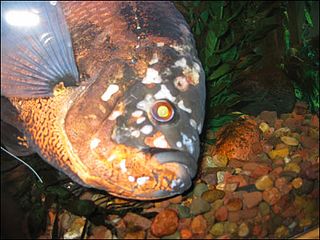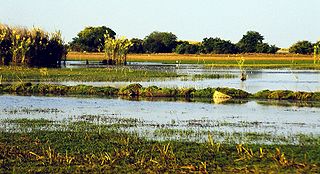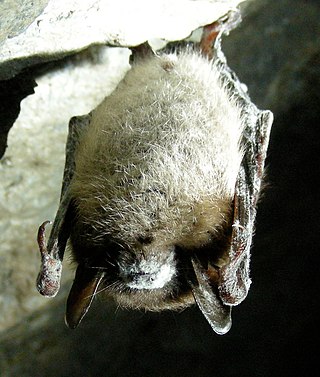
A mouth ulcer (aphtha) is an ulcer that occurs on the mucous membrane of the oral cavity. Mouth ulcers are very common, occurring in association with many diseases and by many different mechanisms, but usually there is no serious underlying cause. Rarely, a mouth ulcer that does not heal may be a sign of oral cancer. These ulcers may form individually or multiple ulcers may appear at once. Once formed, an ulcer may be maintained by inflammation and/or secondary infection.

Zollinger–Ellison syndrome is rare disease in which tumors cause the stomach to produce too much acid, resulting in peptic ulcers. Symptoms include abdominal pain and diarrhea.

Aphthous stomatitis, or recurrent aphthous stomatitis (RAS), is a common condition characterized by the repeated formation of benign and non-contagious mouth ulcers (aphthae) in otherwise healthy individuals. The informal term canker sore is also used, mainly in North America, although it may also refer to other types of mouth ulcers. The cause is not completely understood but involves a T cell-mediated immune response triggered by a variety of factors which may include nutritional deficiencies, local trauma, stress, hormonal influences, allergies, genetic predisposition, certain foods, dehydration, some food additives, or some hygienic chemical additives like SDS.
In epizoology, an epizootic is a disease event in a nonhuman animal population analogous to an epidemic in humans. An epizootic disease may occur in a specific locale, more generally, or become widespread ("panzootic"). High population density is a major contributing factor to epizootics. The aquaculture industry is sometimes plagued by disease because of the large number of fish confined to a small area.
Aphanomyces is a genus of water moulds. As of 2003 there were about 45 described species. Many of these water moulds are known as economically important pathogens of species of plants and animals, including fish, crustaceans, and agricultural crop plants. Aphanomyces water moulds are "one of the most important yield-limiting factors in production of legumes and sugarbeet."

Stomatitis is inflammation of the mouth and lips. It refers to any inflammatory process affecting the mucous membranes of the mouth and lips, with or without oral ulceration.

Head and lateral line erosion, (HLLE) or hole-in-the-head (HITH) is a disease in fish. Chronic ulcerative dermatopathy or chronic erosive dermatopathy are symptoms of similar conditions with different etiology.
Taura syndrome (TS) is one of the more devastating diseases affecting the shrimp farming industry worldwide. It was first described in Ecuador during the summer of 1992. In March 1993, it returned as a major epidemic and was the object of extensive media coverage. Retrospective studies have suggested a case of Taura syndrome might have occurred on a shrimp farm in Colombia as early as 1990 and the virus was already present in Ecuador in mid-1991. Between 1992 and 1997, the disease spread to all major regions of the Americas where whiteleg shrimp is cultured. The economic impact of TS in the Americas during that period might have exceeded US$2 billion by some estimates.

Pyoderma gangrenosum is a rare, inflammatory skin disease where painful pustules or nodules become ulcers that progressively grow. Pyoderma gangrenosum is not infectious.

Channa striata, the striped snakehead, is a species of snakehead fish. It is also known as the common snakehead, chevron snakehead, or snakehead murrel and generally referred simply as mudfish. It is native to South and Southeast Asia, and has been introduced to some Pacific Islands. Reports from Madagascar and Hawaii are misidentifications of C. maculata.

The Bangweulu Wetlands is a wetland ecosystem adjacent to Lake Bangweulu in north-eastern Zambia. The area has been designated as one of the world's most important wetlands by the Ramsar Convention and an "Important Bird Area" by BirdLife International. African Parks began managing Bangweulu in partnership with Zambia's Department of National Parks and Wildlife with the establishment of the Bangweulu Wetland Management Board in 2008.
Photobacterium is a genus of gram-negative, oxidase positive and catalase positive bacteria in the family Vibrionaceae. Members of the genus are bioluminescent, that is they have the ability to emit light.
Snakehead rhabdovirus (SHRV) is a novirhabdovirus that affects warm water wild and pond-cultured fish of various species in Southeast Asia, including snakehead for which it is named.

White-nose syndrome (WNS) is a fungal disease in North American bats which has resulted in the dramatic decrease of the bat population in the United States and Canada, reportedly killing millions as of 2018. The condition is named for a distinctive fungal growth around the muzzles and on the wings of hibernating bats. It was first identified from a February 2006 photo taken in a cave located in Schoharie County, New York. The syndrome has rapidly spread since then. In early 2018, it was identified in 33 U.S. states and seven Canadian provinces; plus the fungus, albeit sans syndrome, had been found in three additional states. Most cases are in the eastern half of both countries, but in March 2016, it was confirmed in a little brown bat in Washington state. In 2019, evidence of the fungus was detected in California for the first time, although no affected bats were found.
Bacterial cold water disease (BCWD) is a bacterial disease of freshwater fish, specifically salmonid fish. It is caused by the bacterium Flavobacterium psychrophilum, a psychrophilic, gram-negative rod-shaped bacterium of the family Flavobacteriaceae. This bacterium is found in fresh waters with the optimal growth temperature below 13 °C, and it can be seen in any area with water temperatures consistently below 15 °C. Salmon are the most commonly affected species. This disease is not zoonotic.

Epizootic ulcerative syndrome (EUS), also known as mycotic granulomatosis (MG) or red spot disease (RSD), is a disease caused by the water mould Aphanomyces invadans. It infects many freshwater and brackish fish species in the Asia-Pacific region and Australia. The disease is most commonly seen when there are low temperature and heavy rainfall in tropical and sub-tropical waters.

Diseases and parasites in salmon, trout and other salmon-like fishes of the family Salmonidae are also found in other fish species. The life cycle of many salmonids is anadromous, so such fish are exposed to parasites in fresh water, brackish water and saline water.
Salmonid herpesvirus 3 (SalHV-3) is a species of virus in the genus Salmonivirus, family Alloherpesviridae, and order Herpesvirales.

The carp louse Argulus coregoni is an obligate ectoparasitic branciuran species on fish. It occurs in China and Japan, and Scandinavia. Argulus coregoni can pose a threat to fish kept in fish farms.











